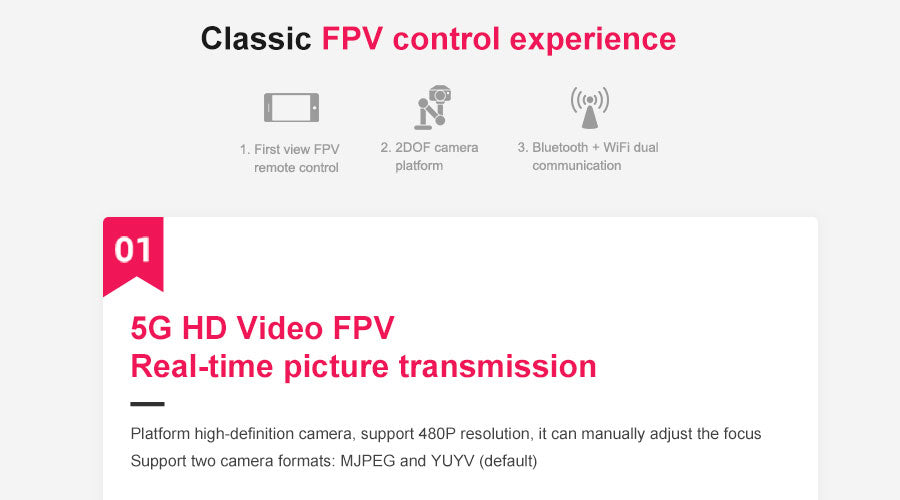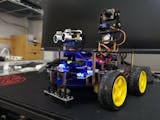
Yahboom Raspberry Pi 4WD Smart Robot is specially designed for educators, students, and Raspberry Pi enthusiasts. Most of the components are connected with screw, copper pillar and anti-reverse socket, which is the same as our other smart robots. The difference for our 4WD robot is that we use the latest Raspberry Pi 4B board as the core controller and HD camera with two degrees of freedom. Through the 5G WIFI network of Raspberry Pi, the real-time transmission of HD video can be realized. Coupled with the high-quality Bluetooth 4.0 module, so we can control car by Android/iOS mobile APP. In addition, we have created a series of AI visual gameplay based on OpenCV, such as face detection, color tracking, object detection, etc. Users can not only learn about the robot car with our robot kit but study the Raspberry Pi 4B board included in this product separately. We can match it with a mouse and a keyboard to form a microcomputer, plus various sensor modules and communication modules so that you can create more possibilities.
Feature
- This robot kit is easy to assemble and features aluminum alloy chassis, powerful four-drive motors, metal motor mount, and High-quality battery.
- BST-4WD multi-functional expansion board is equipped with interfaces of various sensors and communication modules, and it is compatible with four core controllers: Arduino UNO, 51 controllers, STM32 and Raspberry Pi.
- It supports multiple functions: Intelligent light-seeking, Tracking, Ultrasonic obstacle avoidance, turn off the fire with a fan, etc.
- It supports multiple AI functions: Face detection, color tracking, object/QR code recognition etc.
- Some holes are reserved in the external structure for users to expand by themselves.
- Users can use C language programming and Python programming.
- This robot and camera platform can be controlled by APP remote control by Android/iOS mobile. And the Raspberry Pi comes with 5G WIFI for real-time transmission of HD video.
Product parameter

Package list

Documents
Yahboom Raspberry Pi 4WD robot
Customs, Duties and Taxes
Our term is FOB Shenzhen which doesn’t include custom fee. You should expect to pay any amount charged by the government in your respective country. This includes, and is not limited to, duties, taxes and any extra fees charged by the courier company.
Free Shipping Policy
Start Date - All Time
End Date - All Time
Order less $50 - You have to pay shipping fee, $10 by default (small package Air), or $20 by DHL.
Order over $50, less $150 - Your order could enjoy free shipping by small package Air, or $15 by DHL.
Orders over $150 - Your order will enjoy free shipping via DHL. In most cases, it takes 3-5 working days to arrive.
Exceptions - Orders from countries in Zone 9 are over $300 for free DHL shipping. To see a full list of countries in zone 9, click here.
Order less $100 - Shipping fee is $45 by DHL.
Order over $100, less $200 - Shipping fee is $35 by DHL
Order over $200, less $300 - Shipping fee is $25 by DHL
Orders over $300 - Free shipping by DHL
Some of our products come with battery and motor. If DHL is not available to your country, we will change DHL to UPS, Fedex, or special line, depending on your country.
Distributors are not eligible for free shipping.
Shipping Method
|
Shipping Method |
Delivery Time(business day) |
Tracking No |
Weight Limit |
|
DHL |
5-7 |
YES |
No |
|
UPS |
5-7 |
YES |
No |
|
Fedex |
7-10 |
YES |
No |
|
Special line |
10-15 |
YES |
No |
|
Small Packets Air |
15-30 |
YES |
No |
After your package is sent out, you can see your tracking number on our website. We will also inform you via email about your tracking number and tracking link.
Shipping Address
We will ship according to the shipping address you provided, please notify us any address change before we update your tracking number.
Combined shipping
We could help combine shipping of multiple orders, please choose combined shipping method in the latter order and notify us in the comment of the order you want to combine.
Insurance
We do not offer insurance which covers you in the unlikely event that your parcel is lost or damaged by the postal services.
Reception
With standard courier practice, you check the contents of the parcel before signing for your goods. If you do not we can't be held liable for any damage that may have occurred in transit.
Remote region
If you are in a remote area, we will communicate with you by email about the extra cost of freight.
Warranty
*Worldwide free shipping
*30-day free replacement
*90-day warranty for parts/repair
*Lifetime free technical support
User Manual Download: http://www.yahboom.net/download
Having problems? Need help?
Please email us at: support@yahboom.com
*Providing photos and videos illustrating your problems will help us serve you much faster.
Payment

PayPal
The main Payment method is Paypal. If you have paypal, that is great. You can simply place order and check out with few steps. If you don't have Paypal account, you can register it and pay by Credit or Debit Card.
Pay with Paypal

Pay with Credit or Debit Card

Your payment information is processed securely. We do not store credit card details nor have access to your credit card information.
Questions & Answers
Have a Question?
-
Cannot get the visual display from the camera to show. Everything else works, no visual from the camera. Get an error message on the display. It is plugged into the raspberry Pi board using the usb terminals, no picture
Thanks for your question.
Could you contact our Technical Support by E-mail (support@yahboom.com), he will help you solve the problem ASAP.
Thanks in advance. -
How do you know when do charge the battery pack? The Lower power indicator light on the expansion board is on when I charge it, will the light go out when the battery charge is low?
Thanks for your question.
The two indicators on the expansion board are 12.6V voltage indicator and 5V voltage indicator.
In generally, the working time for a fully charged battery is 180 minutes, you can charge the battery pack after using it for such a long time.
Please remove the battery pack from the car before charging, and then use the charger provided by us to charge the battery pack.
During charging, the charger indicator will be red and the full charge indicator will become green. -
IPhone Bluetooth device not listed. What should I do?
The iOS phone see the Bluetooth module of robot car.About how to connect Bluetooth, you can view this video. -
I purchased the 4wd robot car kit but Bluetooth is not connecting, beep sound not coming and Bluetooth chip hitting in4wd car
Hi friend, send your question to this E-mail:support@yahboom.com
Our technical support will help you solve the problem as soon as possible. -
I purchased the 4wd robot car kit but Bluetooth is not connecting in4wd car
Hello friend,Sorry for late reply. We didn't work on weekend, so i didn't check and reply you.
Please send your question to this E-mail:support@yahboom.com. Our technical support will reply to you ASAP. -
Hi! How could I extract the velocity of the 4 motors? I am not sure if this car has encoders includeed in the motors. For over a month I've tried reading the velocity from the motors but I didn't succed....
Hello friend,
This motor didn't with encoder. -
Assembled size listed is 256x783x213 mm, what is the dimensions order? 256mm height and 783mm length, or vice-versa?
Hi friend,
Could you contact me by E-mail: market@yahboom.com ?
I will send the picture for you about your robot size. -
Are they Giving SD card along with Raspberry pi 4B Board?
Yes. We will provide SD card along with Raspberry pi 4B Board.




































